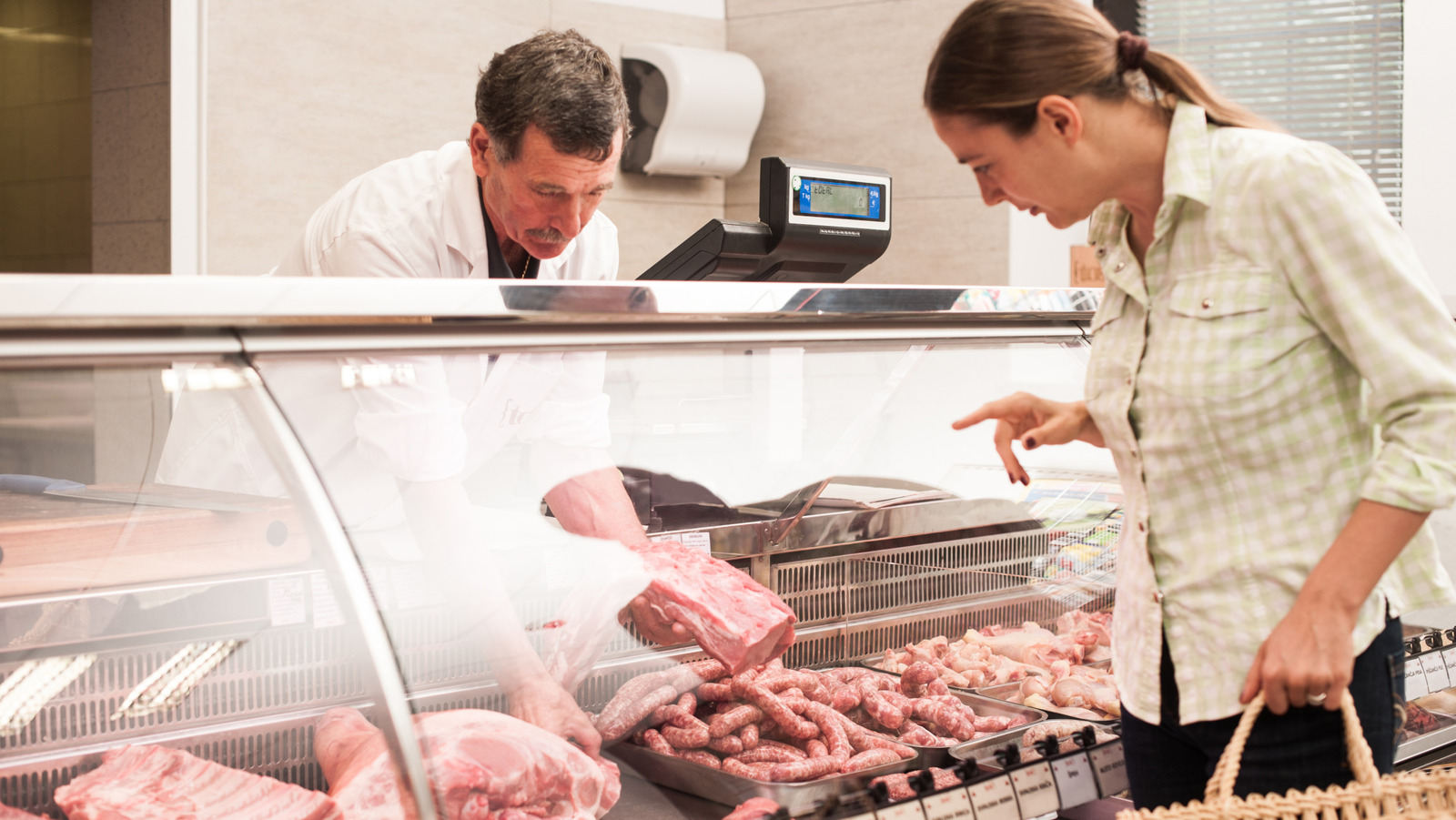Your heart is racing. Your breath is unsteady. Your frantic eyes can’t keep focus. Is that sweat dripping down your forehead? Nope, this isn’t a first date. You’re just (very) nervous to approach the butchers behind the meat counter at your grocery store. If you’re used to only buying packages of pre-cut meat, it can be a fairly nerve-wracking shift to interact with a professional butcher to purchase your meat supply. Those huge cleavers and saws look pretty darn intimidating. Not to mention all that blood. So what are you supposed to say? More importantly, what are the things you definitely shouldn’t say?
Whether you’re an anxious newbie shopping for the first time at your local butcher shop or if you’re a meat department enthusiast and need a quick refresher, there is a lot to learn regarding butcher shop etiquette. Read through this list to hone in on the top 12 things you should never say to your butcher, with helpful advice directly from a skilled expert in the industry.
I interviewed Steve Baker, a professional butcher at Whole Foods Market with over six years of butchering experience. Baker offers his wisdom, humor, and years of practice on how customers can avoid the biggest mistakes and faux pas when talking to a butcher and how to be a more knowledgeable and respectful shopper when purchasing meats.
Is this fresh?
As long as you are a patron of a reputable butcher shop, unquestionably, there will be high standards of quality in place to offer you the freshest available meats. A common butcher shop misconception Baker points out is that butchers are “just putting things in the case to get rid of them whether they’re fresh or not.” In reality, professional butcher shops and meat departments of grocery stores follow — often as required procedures that must be completed — proper flow charts of receive dates, cut dates, and expiration dates. Adhering to these set guidelines, the meat will be disposed of well before it loses quality.
“Butchery is currently enjoying a bit of a renaissance, and we’re certainly not working in the places that Upton Sinclair wrote about in The Jungle anymore,” Baker continues. “In today’s world, if shops aren’t offering the freshest and highest quality produce possible, they’re not going to survive for long. There are just too many options out there now for customers to accept anything that’s of a lesser quality.” Most quality-focused grocery stores and butcher shops now have public transparency regarding meat sourcing. At Whole Foods Market, the company website includes a section dedicated to explaining the store’s meat department quality standards, like animal-specific welfare practices, diet requirements, and traceability measures.
I want the best cut in the case
Another misunderstanding is believing that one cut of meat is regarded as the best compared to all others. Baker is often asked by customers if they could get whatever is best in the case, but he does not agree with that particular request. Baker explains that it “really depends on what you’re making. A cut that’s the best for one recipe may not be the best for another. I’m never going to recommend you grill an eye of round, just like I’d never recommend you braise a filet mignon. There are a lot of folks that get hung up on the idea that the higher a price tag, the better it must be.”
Beef, veal, lamb, pork, and poultry all have a multitude of cuts per animal at varying costs, and all have their own unique taste, texture, optimal prep and cooking techniques. Baker continues, “We also don’t want to just sell you the highest-priced item just because we can. None of us make a commission, so we really just want to give you a piece of meat that’s going to produce the best results for your recipe.”
Is there anything else in the back?
As in all food retail departments, including the butcher shop, there are indeed storage areas, pantries, and/or walk-in coolers and freezers to hold more products. However, it’s a common assumption that butchers keep a super-secret, super-special stash in the back of top-shelf items that are intentionally hidden away from customers. There is no secret password that will get you the good stuff, no golden calves or golden-egg-laying geese that are carefully guarded by the butcher staff for their own selfish feasting.
What is kept in the back is often nothing other than extra inventory and backstock overflow of what’s already available that cannot fit in the case or primal cuts that are too large to be stored elsewhere and will be broken down later. There really is no point in customers asking if there is anything else the butchers aren’t currently displaying.
Butchers absolutely want you to buy the best they offer. Baker explains it best by saying, “I care deeply about what I’m putting in that case for display every day, and do the best I can to offer nothing but the highest quality available.” There are no lies and trickery, or attempting to dissuade customers from looking behind the big curtain.
Your butcher shop looks really gross
Steve Baker recognizes how easy it is “to think that because we work in the business of blood and bones that everything must be dirty.” When you reach the meat counter to order something, you may be a little uneasy to see messy countertops, cutting boards, floors, tools, and equipment during the butchering process. The butchers themselves might even be covered in blood on their gloves and aprons. But you can breathe easy with the knowledge that everything is cleaned and sanitized routinely and rigorously to follow strict regulations. Even though a butcher shop constantly works with raw meat, it is a common misunderstanding that it is a disgusting operation. Quite oppositely, the very fact that butcher shops handle raw meat necessitates rigorous standards for food handling safety and sanitation.
Baker further explains that “there are a lot of processes to ensure everything is done as cleanly and safely as possible.” Reputable butcher shops and meat departments follow standard operating procedures with cleaning and sanitation. As per the Food Safety and Inspection Service (FSIS), a subset of the United States Department of Agriculture, sanitation standards must be maintained by all official meat and poultry establishments, including butcher shops and grocery store meat departments. Meat departments in grocery stores such as Whole Foods must also undergo routine visits from food safety organizations.
Can I get a lower price for this?
No haggling, please! Your attempts will ultimately be futile. The majority of established grocery stores and butcher shops have fixed prices that cannot be negotiated by even the most resolute of customers determined to get a little money off. The price of meat products, whether sold by weight or by individual units, is figured in advance by analyzing a medley of factors, including the type of meat, the grade of meat, the sourcing of the meat, and the labor cost for processing and butchering. Small-business butcher shops may have more flexibility with prices, but meat departments in larger grocery stores must strictly abide by a chain of command — butchers are typically not the decision-makers when it comes to setting costs. Other hired positions completely separate from store-level departments, such as retail category managers or pricing analysts, are responsible for determining prices.
A more effective and courteous method of saving money is to note upcoming sales and deals instead. Make sure you know how to obtain weekly or monthly flyers from your grocery store or local butcher and sign up for any online subscriptions or email updates to receive the most current information. There may also be loyalty programs you can join for exclusive deals, a more common offer in larger grocery store chains. Also, you can buy sales items in bulk and properly freeze the meat for later use.
Give me an exact weight
No food service professional looks forward to the all too frequent experience of interacting with hyper-obsessive shoppers when their difficult behavior is completely unwarranted. Simply put, no one likes a rude customer. Many butchers, like Baker, have chosen the profession not just to learn an artisanal food craft but also to “help feed people.” They will offer you the best service and the best products they can offer. And the whole shopping experience can be quick, painless, and enjoyable for everyone involved, both butcher and customer, without any constant nagging.
An off-putting behavior to note here is when customers are excessively demanding about getting a precise weight on a cut of meat at the butcher counter. While butchers will do what they can to cater to a customer’s request, sometimes it might be impossible to get the exact weight of what they want with certain cuts. This is the case with pieces that basically come as they are and are difficult to break down into bigger or smaller portions, such as poultry legs and wigs, legs, and shanks from smaller animals like veal and lamb, as well as various offal like hearts, livers, and sweetbreads. Rest assured that there will be no harm done to the cooking process if the weight of what you are ordering is over or under an ounce or two.
I need to order a lot immediately
A frustrating annoyance for the food industry as a whole, let alone for one single department, it’s the bane of every food professional’s career when a customer demands a huge order with no warning. It’s an unrealistic expectation for customers to believe that a food retail business will always have exactly what they need on any given day. While we, as members of the hospitality sector, always strive to satisfy our customers, there are plenty of situations when we must refuse service.
For butchers in particular, there is a very practical reason why bulk orders usually cannot be fulfilled without advance notice. “It’s important to remember these are animals we’re working with, and there are a limited number of pieces to everything,” says Baker. That’s why Baker recommends shoppers should plan ahead with bulk orders. He advises, “If you know you need a lot of something, give a few days’ notice so we can make sure we can get it all in for you.” Even if you don’t have an upcoming event, consider contacting your butcher anyway to ask them how much time they prefer to have in advance if you need to place a larger order. They’ll certainly appreciate your consideration of their time and resources, and you’ll be wiser knowing exactly what to do in the future.
But the recipe says …
This scenario happens all the time: You go into the grocery store or butchery excited and hungry to shop for a new recipe you want to cook, and they are completely out of stock of the meat you need for it! Cue low-key panic mode. You really don’t want to deal with the inconvenience of traveling to a different store for just one item. But the recipe specifically says you need THIS or THAT cut of meat. You could find a different recipe entirely, complain that the store never has what you need, or better yet, you could trust the expertise of your butcher by accepting suggestions for an alternative cut.
Rather than frantically argue with the butcher about following the recipe exactly or forgoing the recipe entirely to make something else, rely on your butcher to offer another cut of meat that would work. Calmly start a conversation about what recipe you are trying to make, and they’ll be able to help you with the information you provide. Believe in your butcher to offer you the best advice if a recipe is not followed exactly. While you may be a little frustrated that you might have to accept a substitution, keep an open mind to other suggestions provided by the real pros of the business. They’ll be able to recommend other cuts that will yield similar results as the original ingredient.
You can prepare it for me special, right?
Ah, the special request. What can you do with a little wink-wink, nudge-nudge? Given how often you shop there, you may be chummy with the butcher and may even be on a first-name basis. But it’s a critical faux pas to assume your friendly butcher buddy can fulfill a special request just because you asked nicely.
There are many reasons why a butcher might immediately deny your request. Here are just a few: They may not have the right cut available, they may not have the right equipment, the equipment might be temporarily out of order, the butcher on staff may be new and not fully trained to handle a more complicated request, or they simply don’t have the time to fulfill your customized order.
Again, the respectful move is to always plan ahead. Contact your butcher or the meat department if you need to make a customized order that is not typically available. With that act of thoughtfulness, you’ll be able to maintain an even stronger relationship with your butcher.
That looks different than what I bought last week
As much as butchers value consistency in their work, they also need to accept (and so should you) that livestock are members of this natural world and will always vary by weight, size, and structure from animal to animal. With so many circumstances to consider, butchers must expertly adapt how they cut and clean the meat they currently have.
The animals’ diets and amounts of exercise will contribute significant differences in the overall appearance and structure of the meat. Being fed a diet that fluctuates seasonally versus being given a consistent ratio of certain feeds and supplemental sources will cause the meat to vary. If the animals are allowed free range in fully open pastures with ample exercise, the color and structure of the butchered meat will also change. For one reason or another, butchers may need to purchase primal cuts from a different purveyor than usual, which may also lead to changes in the look of the meat.
And as another point, the butcher case will often fluctuate in organization and presentation on a weekly — if not daily — basis. Baker is often in charge of the case presentation and “fell in love with creating the displays,” which change regularly depending on what meats are currently in stock. So don’t be frustrated if you can’t initially find what you were looking for, as there’s a very good chance it’s just in a slightly different spot than last week.
Oh, I would NEVER eat that!
But have you ever cooked lamb neck? Or chicken livers? Or pig feet? Or oxtails? With the right preparation, they’re all delicious. Whether it’s due to your food pickiness or your hesitation with a new cooking method, don’t let your fear dictate an immovable decision to cling to the same pieces of meat you have eaten for years. “Try something new,” Baker exclaims. “It’s very easy to get stuck making the same old things for dinner night after night, week after week. We all have our favorite dishes and favorite cuts, but there is a whole world of recipes and cuts to choose from.”
If your butcher is eager for you to try a different cut or type of meat, maybe something the shop can only bring in for a limited time, don’t be afraid to step outside of your cozy comfort zone. Most skilled butchers will also know how to prepare and cook their products for the best and most appetizing results, so they are stellar sources of information to access when the time is right. In the end, buying and cooking something new is a low-risk enterprise. Follow Baker’s reassuring advice when he says, “The worst thing that could happen is it doesn’t turn out right, and you order a pizza. And who doesn’t like pizza?”
So, I know you’re busy … but how do I cook this?
While butchers are excited and experienced in offering cooking advice to curious customers, be mindful of differentiating between appropriate and inappropriate times to inquire. There are certain situations when expecting the butcher to stop what they’re doing and exclusively cater to you is just plain bad timing. For example, don’t ask for cooking advice during busy weekends or while your store is in the thick of pre-holiday shopping. You really don’t want to interrupt business transactions when lines are long, tempers are high, and everyone’s patience is running thin, so you can get a fully detailed explanation of how to cook a standing rib roast. With common sense on your side, choose times to have a discussion with your butcher that don’t involve holding up a large line of other hustling and bustling shoppers.
Doing some of your own research will also be a huge help in the process of obtaining cooking tips from your butcher. Baker says that you, as the customer, should “have a basic idea of what you’re trying to make and how many people you’re feeding. I can answer mostly any questions you may have about a cooking process or about what cut to choose, but I have to know where to start.” Before you start a conversation with your butcher, study the basics: what cut you want, what recipe you want to make, and the basic cooking procedure.





